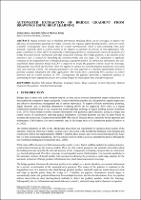Chapter Automated Extraction of Bridge Gradient from Drawings Using Deep Learning
Author(s)
Bayer, Hakan
Faltin, Benedikt
König, Markus
Language
EnglishAbstract
Digital methods such as Building Information Modeling (BIM) can be leveraged, to improve the efficiency of maintenance planning of bridges. However, this requires digital building models, which are rarely available. Consequently, these models must be created retrospectively, which is time-consuming when done manually. Naturally, there is a great interest in the industry to automate the process of retro-digitization. This paper contributes to these efforts by proposing a multistage pipeline to automatically extract the gradient of a bridge from pixel-based construction drawings using deep learning. The bridge gradient, a key element of the structure’s axis, is critical for describing the elevation profile and axis slope. This information is implicitly contained in the longitudinal view of bridge drawings as gradient symbols. To extract this information, the well-established object detection model YOLOv5 is employed to locate the gradient symbols inside the drawings. Subsequently, EasyOCR and heuristic rules are applied to extract the relevant gradient parameters associated with each detected symbol. The extracted parameters are then exported in a machine-interpretable format to facilitate seamless integration into other applications. The results show a promising 98% accuracy in symbol detection and an overall accuracy of 70%. Consequently, the pipeline represents a significant advance in automating the retro-digitization process for existing bridges by reducing the time and effort required
Keywords
Building Information Modeling; Computer Vision; Deep Learning; Symbol Detection; Optical Character Recognition; Construction DrawingsDOI
10.36253/979-12-215-0289-3.68ISBN
9791221502893, 9791221502893Publisher
Firenze University PressPublisher website
https://www.fupress.com/Publication date and place
Florence, 2023Series
Proceedings e report, 137Classification
Virtualization


 Download
Download Web Shop
Web Shop